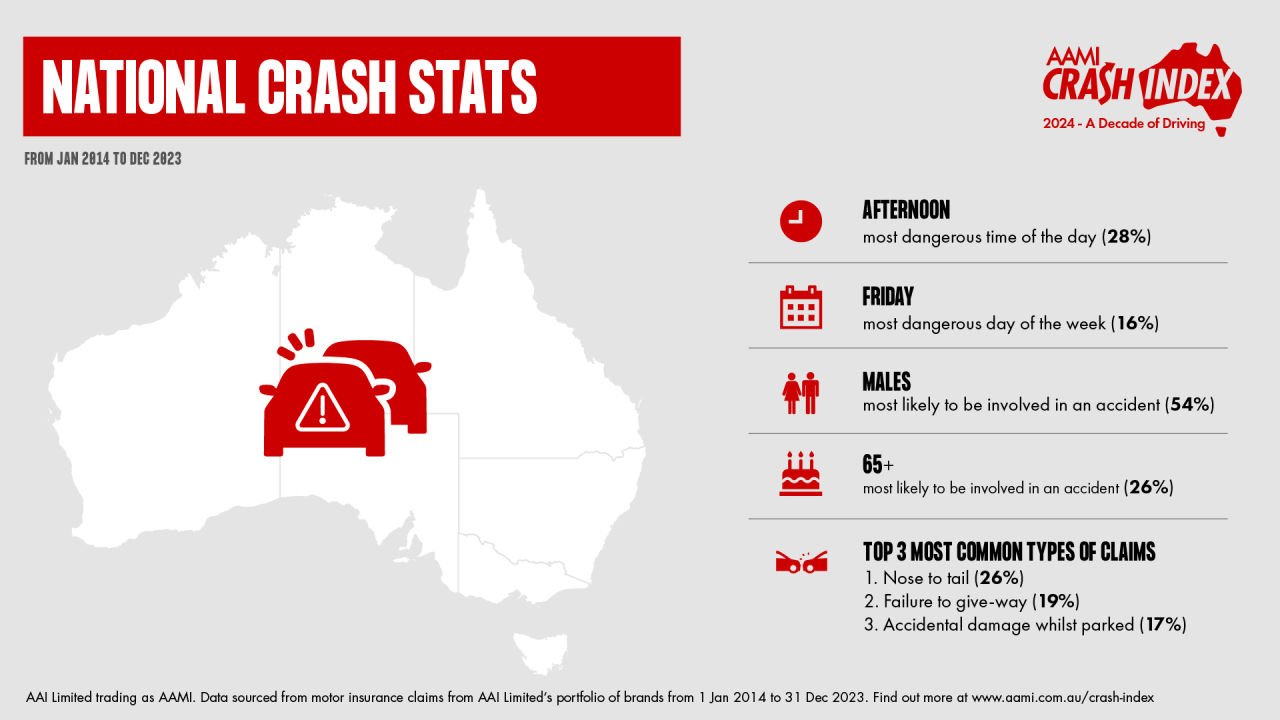AAMI releases a special Decade of Driving Report, as part of its Crash Index 2024
Suncorp's national insurer AAMI has released a special Decade of Driving Report as part of its annual Crash Index. The report examines 10 years of claims data to find trends of the past, so we can look forward to the future to see how we can improve road safety for all Australians.
Share

Analysing more than 4.3 million motor claims across the country from 2014 – 2023, AAMI’s Decade of Driving Report aims to shine a light on the country's most dangerous crash hotspots. It features road safety experts and provides unique insights into accidents and driving behaviours and how they've changed, as well as how we can better protect all road users.
#Key takeaways from the report
- Nose-to-tail is the most common type of crash across the country
- Friday is the most common day, and afternoons worst time for accidents nationally
- Male drivers and motorists aged 65+ are the worst offenders on Aussie roads
#Australia's most notorious crash hotspots
Plenty Road, Bundoora, in Melbourne’s north-east, has the dishonourable title of being Australia’s most dangerous crash hotspot of the past decade.
However, other states shouldn’t be too quick to gloat, as AAMI's Decade of Driving Report identifies the following top crash hotspots around the country:
#National Crash Hotspots

#Australia's top crash hotspots 2014-2023
| #1 Hotspots | Road | Location |
| Victoria | Plenty Road | Bundoora |
| New South Wales | Hume Highway | Liverpool |
| Queensland | Bruce Highway | Rockhampton |
| Western Australia | Albany Highway | Cannington |
| Australian Capital Territory | Canberra Avenue | Fyshwick |
| South Australia | Marion Road | Marion |
| Tasmania | Sandy Bay Road | Sandy Bay |
| Northern Territory | Stuart Highway | Darwin |
#Other national insights over the past decade include:
- TGI Friday?: Friday was the worst day of the week for crashes (16%), followed by Thursday and Wednesday. Surprisingly, the weekend (Sunday then Saturday) were the days Aussies were least likely to have an accident.
- Beware the afternoon slump: The worst time of day for a crash has not changed over the past 10 years - afternoons between 1-4:30pm. Mornings between 9:30am-1pm, followed by late afternoon from 4:30–8pm are the other worst times to be on the road.
- Keep your nose out of other people’s business: The most common collision on Aussie roads was nose to tail crashes (26%). Over the past 10 years, drivers were also frequently failing to give-way (19%), and accidentally damaging cars while parked (17%).
- Women on top: When it comes to the battle of the sexes – it seems male drivers (54%) were significantly more likely than females (46%) to have a crash, while older drivers aged 65+ were interestingly the most dangerous behind the wheel, with more than a quarter (26%) of claims being attributed to them.
#National Crash Statistics


#Insights from Leah James, AAMI Motor Claims Manager
- “While there have been many changes, and technological advances, to the types of vehicles we drive since we started the AAMI Crash Index in 1994, AAMI's Decade of Driving Report found that unfortunately we haven’t changed much about the way we drive.
- "Nose to tail crashes and failing to give-way are consistently the top types of accidents, indicating that as a nation, we have a propensity to tailgate other drivers and drive distracted.
- "Since 2014, our data has shown that afternoons are prime time for collisions across the country. This coincides with school pick up – and is generally a time when the roads are busy, patience is wearing thin, drivers are tired from the day and racing to either get home or to their next destination. This is when drivers need to have their wits about them, and be vigilant behind the wheel, to avoid those bumper-to-bumper collisions or an accident involving a child.
- "The number one crash hotspots in each state and territory are all notorious for accidents and share similar attributes of being busy major roads, or main thoroughfares through industrial, educational, shopping centre precincts or central business districts. In all states, except for Tasmania, the #1 hotspot has held the top position in their state for more than five of the past ten years, indicating that not only are these roads busy, but also dangerous.
AAMI Motor Claims Manager Leah James
For the past three decades, the AAMI Crash Index has been educating drivers on the importance of using
safe driving habits and avoiding behaviours that lead to accidents.
- "However, we recognise that it’s not just the responsibility of those behind the wheel, which is why we have shared our crash data with governments at all levels to help identify and plan for future road projects, as well as drive policy changes and road improvements at identified hotspots.
- "In 2022, AAMI’s Crash Index data played a key role in reducing the rate of collisions at the country’s worst crash hotspot – Melbourne's Plenty Road in Bundoora. Our data helped inform a speed reduction trial which then went on to become a permanent change in 2022.
- "Following the adoption of the reduced speed limit, our data showed a 26 per cent reduction in the number of accidents*, demonstrating the positive impact the AAMI Crash Index has had on saving lives.
AAMI Motor Claims Manager Leah James
What we hope to achieve with our AAMI Decade of Driving Report, is to bring awareness to where, when
and how accidents occur, so that Aussie drivers can be better informed and educated on how to drive more
safely.
Claims data collected from AAI Limited trading as AAMI. Data sourced from motor insurance claims from AAI Limited's portfolio of brands from 1 Jan 2014 to 31 Dec 2023.
* Motor claims from FY19-FY23.



